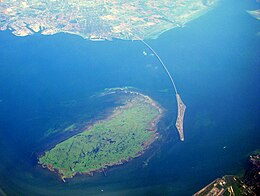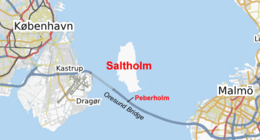 Saltholm (left) and Peberholm (right) in 2011 | |
 Location of Saltholm in the Øresund | |
| Geography | |
|---|---|
| Location | Øresund, Baltic Sea |
| Coordinates | 55°38′N 12°46′E / 55.633°N 12.767°E |
| Area | 16 km2 (6.2 sq mi) |
| Length | 7 km (4.3 mi) |
| Width | 3 km (1.9 mi) |
| Highest elevation | 5 m (16 ft) |
| Highest point | unnamed |
| Administration | |
Denmark | |
| Region | Hovedstaden |
| Municipality | Tårnby |
| Largest settlement | Holmegård (pop. 2) |
| Demographics | |
| Population | 2 (2021) |
| Pop. density | 0.12/km2 (0.31/sq mi) |
| Ethnic groups | Danish |


Saltholm (Danish pronunciation: [sæltˈhʌlˀm]; Salt Islet) is a Danish island in the Øresund, the strait that separates Denmark and Sweden. It is located to the east of the Danish island of Amager in Tårnby municipality and lies just to the west of the sea border between Denmark and Sweden. The island is 7 km long and 3 km across at its widest point. With an area of 16 km2, it is Denmark's 21st largest island. Saltholm is very flat; its highest point stands only 2 m (6 ft) above sea level, rendering it vulnerable to flooding if persistent east winds cause a tidal surge in the Baltic Sea.[1] It is a relatively new landmass in geological terms, having risen from the sea about 4,000 years ago due to post-glacial rebound, and is surrounded by a large area of shallow water (of 2 m depth or less) that covers an area of 28 km2 (11 sq mi). A series of islets, inlets and rock deposits from the last ice age appear at the south end of the island.[2]

Its neighboring island to the south is the artificial island Peberholm (Pepper Islet), which is a part of the Øresund Bridge and was named to complement Saltholm. Sometimes, Saltholm and its neighboring island to the north, Ven, are referred to as the Øresund Islands.
- ^ Aage Aagesen, Niels Nielsen, Kongelige Danske geografiske selskab, Atlas over Danmark, p. 117. H. Hagerup, 1992
- ^ "Saltholm". The Sound Water Cooperation. Øresundsvandsamarbejdet. Retrieved 14 January 2009.